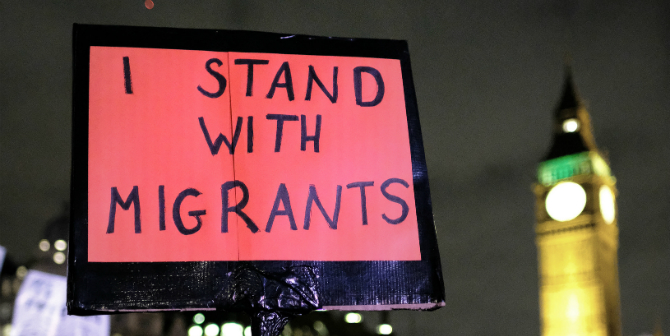 EU27 citizens who wish to stay in the UK after Brexit must take part in the new EU Settlement Scheme meant to replace the previous legal route to securing permanent residence. Once that has been obtained, they can opt for naturalisation. Chris Moreh (York St John University) looks at which option they are choosing, and examines attitudes to naturalisation from the findings of a survey of EU nationals carried out just before the referendum.
EU27 citizens who wish to stay in the UK after Brexit must take part in the new EU Settlement Scheme meant to replace the previous legal route to securing permanent residence. Once that has been obtained, they can opt for naturalisation. Chris Moreh (York St John University) looks at which option they are choosing, and examines attitudes to naturalisation from the findings of a survey of EU nationals carried out just before the referendum.
The 2016 referendum vote to leave the European Union is already having noticeable demographic consequences. Work-related migration to the UK from other EU countries – as measured by new National Insurance Number registrations – has fallen in 2018 to its lowest level in five years (Figure 1). In fact, migration from the eight non-Commonwealth Central and Eastern European countries that joined the EU in 2004 (the “EU8”) has registered the lowest level since that EU enlargement.

At the same time, the overall number of National Insurance registrations last year still reached well above 400,000, and the decreasing tendency is slower for certain nationalities. Romanian nationals – who joined the EU in 2007 together with Bulgaria (the “EU2”) – are still arriving in relatively high numbers, and migration from the four Southern-European old member states (Portugal, Spain, Italy and Greece) is still double that from the ten Northern and Western European EU countries, a trend traceable back to 2012 (Figure 1). Other data from the Office for National Statistics likewise show that during 2018 in-migration was lower than out-migration only for EU8 nationals, while net migration from other member states was still positive.
Figure 1: NINo registrations (2002-2018)
The legal integration of EU migrants
The referendum result has also affected the legal integration of EU nationals living in the country. While freedom of movement rights generally allow EU citizens to live long-term in another member state without having to acquire any documentation from the authorities of their country of residence, the triggering of Article 50 in March 2017 meant that the UK government had to begin planning new legal instruments to integrate the residence rights of EU citizens living in the UK into national-level immigration law. The instrument eventually implemented is the so-called EU Settlement Scheme, which had gone through three testing phases between August 2018 and April 2019 that included various selected segments of the target population. Officially open since 30 March 2019 – the day by which the UK was due to leave the EU before an extension to Article 50 was agreed – all EU, EEA and Swiss citizens and their family members are required to participate in the scheme by 30 June 2021 and obtain either ‘settled’ or ‘pre-settled’ status if they plan to remain in the country following that date.
In parallel to this new scheme, EU nationals could still apply for a certificate confirming their permanent resident status (PRC) derived from their free movement rights as per previous rules. Nevertheless, the government currently advises that these documents will not be valid after 31 December 2020, and they also incur a fee of £65 while setting more restrictive requirements than those for ‘settled status’. Although the transition to a national legal residence rights framework is not yet complete, the direction is clear and clearly reflected in the actual application patterns (see Figure 2).
As shown in Figures 2, PRC applications have increased dramatically after the EU referendum compared to previous years. Their number in 2017 was 17 times higher than the average yearly applications between 2007–2015, and 2.5 times greater than in 2016. Provisional data covering the first three quarters of 2018 shows it unlikely that the previous year’s record numbers will be replicated. At the same time, over 223,000 eligible EU nationals have applied for or obtained settled or pre-settled status following the new settlement scheme’s testing phases (Figure 2), and around 400,000 more since its official launch.
Figure 2: Permanent residence and EU Settlement Scheme applications (2007-2019)
Figure 3: Citizenship applications (2007-2018)
Applications for British citizenship have also skyrocketed since the referendum. Given Given that naturalisation requires someone to have held a PRC – or now ‘settled status’ – for twelve months before the application, it is understandable that the number of citizenship applications spiked up with a delay, in 2017, and based on provisional data we can expect naturalisations in 2018 to outnumber those in the year before (Figure 3). Considering the high cost of naturalisation – the current application fee is £1,330 – many applicants are probably motivated by a distrust that other legal statuses will prove permanent residence rights. All in all, Brexit is having an unquestionable effect on the shape of the UK migration system and citizenry.
Is Brexit the only driver of legal integration?
In a recent open access article, however, my co-authors and I investigate whether this turn to naturalisation as a legal integration mechanism among EU migrants is in fact driven solely – or even primarily – by the Brexit effect. We argue that the picture is more complicated than that. Our analysis is based on primary online survey data collected in the months running up to the 2016 EU referendum. The main aim of the survey was to understand the attitudes of EU migrants towards the referendum and to assess their future plans and actions. One question asked was whether they were “planning to apply for British citizenship at any point in the future”. We also asked about their five-year plans regardless of the referendum and about their planned actions in the – at that time still – unlikely event of a vote for Brexit, providing answer options for: leaving the UK, undergoing legal integration or remaining in the UK relying only on free movement rights derived from their EU citizenship status.
Overall, almost two-thirds of our respondents had plans for some form of legal integration (PRC or naturalisation) over the next five years or were open to naturalisation at some point in the future, although there were notable differences among national groups (see particularly figure 3 in that article).
More useful for explanatory purposes, however, is to determine the potential factors that influence these naturalisation preferences. Some of our findings in this respect are summarised in Figure 4. The analysis presented here in based on a sample of 1,240 respondents, of which 60% are Polish nationals, 10% are Hungarians, 9% are Romanians, 14% are from three Southern-European EU member states, and 8% are from three Western European member states. The figure combines results from seven statistical models and shows the probability of intending to apply for British citizenship at any point in the future depending on various characteristics, while also controlling for the effect of five socio-demographic variables: gender, age, parental status, time spent in the UK and the employment status of the respondent and their partner.
Figure 4: Predicting the probability of naturalisation intentions
Overall, 63.3% of the respondents in this sample were planning to apply for citizenship, which in the language of probability corresponds to a factor of 0.633. The vertical line in Figure 4 is meant to visualise this baseline probability. We see, however, that various factors determined whether someone was more or less likely to hold naturalisation plans before the EU referendum. For instance, we find that Poles, Hungarians and Romanians had a statistically significantly higher likelihood to be planning to naturalise as British citizens than those from the older EU member states. The latter were seemingly more comfortable relying on their EU freedom of movement rights. Similarly, those who speak English at work show a significantly higher probability (0.67) to be planning naturalisation than those who speak another language at the workplace (0.50). The same is true of those who speak English at home (0.71) as opposed to another language (0.61). This is all as we would expect, given that using English potentially signals a higher level of socio-cultural integration, which may increase the likelihood of wishing to become a citizen of the country.
Some of the other factors, however, are more interesting for our argument. We see, for instance, that those who migrated not purely for economic reasons but also had socio-political motivations – seeking more civic freedom, better healthcare and schooling opportunities for children, and a stronger welfare state – are significantly more likely to plan naturalisation. Indeed, this factor has the highest predictive value compared to all other factors (0.77). This may imply that attitudes towards naturalisation are often shaped very early on in the migration decision-making process.
The effect of one’s eligibility for naturalisation within one year is also very telling. We find no statistically significant difference in future naturalisation intentions between those eligible and those ineligible, yet both these groups are significantly more likely to be planning naturalisation than those who are unaware of their eligibility. In other words, those intending to naturalise had already taken the first step of familiarising themselves with the eligibility criteria, which again implies an earlier interest in becoming a British citizen. We also see – through the top variable in Figure 4 – that those intending to naturalise are much more likely to have had stable five-year plans which do not change in case of a Brexit vote. Put differently, those with longer-term naturalisation intentions are less likely to have had their short-to-medium term plans disturbed by Brexit, as their plans involved legal integration measures anyway.
The effect of anxiety about the EU referendum poses some challenges for interpretation. We see that those anxious about a potential Leave outcome were also more likely to be planning to become British citizens (0.68). From one perspective, this is clear evidence that the possibility of Brexit was having a noticeable influence on legal integration even before the referendum outcome. However, the direction of causation is unclear, and it could very well be that it was those with long-held naturalisation intentions who felt more anxious about the possibility of their plans becoming complicated by a potential Brexit. This we cannot know. But what this analysis seems to tell us is that national citizenship had been an important legal mechanism by which intra-EU migrants – particularly those from newer EU member states – sought to integrate within the UK’s legal framework even before the EU referendum. For many, freedom of movement rights have always been a means to an end.
This post represents the views of the author and not those of the Brexit blog, nor LSE.
Chris Moreh is a Lecturer in Sociology and Criminology at York St John University.











1 Comments